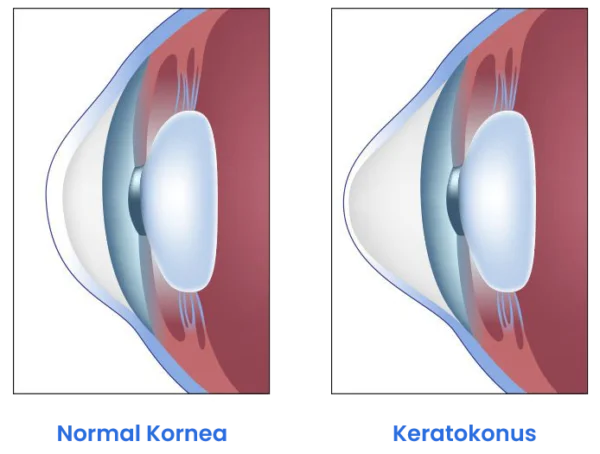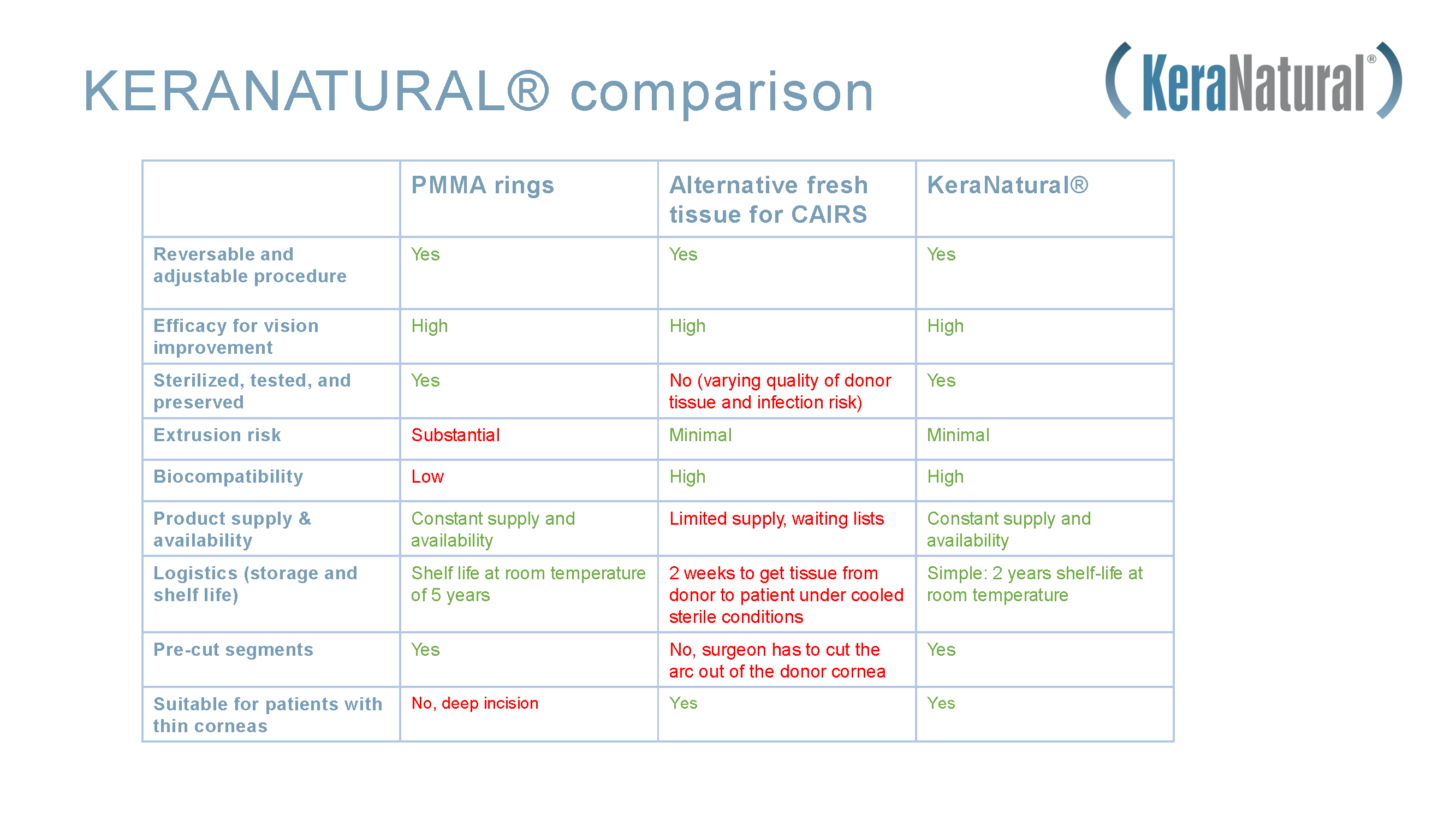Allograft corneal ring therapy is a surgical procedure used to treat keratoconus, a progressive eye disorder that causes the cornea to thin and develop into a cone-like shape. Keranatural is an allograft corneal ring. Very different from Keranatural, traditional corneal ring treatment, also known as intracorneal ring segments (ICRS), involves inserting small plastic rings into the cornea to help flatten and stabilize the cornea.
KeraNatural Treatment
Request an Appointment
KeraNatural in the treatment of keratoconus
Allograft corneal ring treatment, also known as keranatural, is a newer type of corneal ring treatment that uses allograft tissue or donor tissue to create a natural corneal ring. This type of treatment is considered advantageous as it is safer, organic, biological, reversible and adjustable compared to conventional corneal ring therapy.
One advantage of allograft corneal ring treatment is that it uses natural tissue instead of synthetic material, which can reduce the risk of complications such as infection, corneal melting or inflammation. Also, because allograft tissue is biologically compatible, the risk of rejection is low.
Another advantage of allograft corneal ring treatment is that it is reversible and adjustable. Unlike traditional corneal ring treatment, which requires removal of the plastic rings if the patient experiences problems or complications, allograft corneal ring treatment can be easily removed or adjusted as needed.
However, it is important to remember that any surgical procedure carries risks and potential complications. Patients considering allograft corneal ring treatment should discuss the potential risks and benefits with their ophthalmologist or eye surgeon. Also, not all patients with keratoconus may be suitable candidates for corneal ring treatment and other treatment options may be necessary.
Frequently Asked Questions
Although the exact cause of this disease is unknown, it can be said that genetic inheritance, ultraviolet radiation, hard lens use, environmental factors, eye trauma such as allergic eye itching are effective in the development of keratoconus. According to the latest information of today’s modern medicine. For this reason, it is of great importance for the early diagnosis and treatment of the disease to perform routine eye examinations while performing detailed examinations such as corneal topography in children with a family history of keratoconus.
Keratoconus can also occur at an early age. However, research shows that keratoconus most often starts during adolescence. The patient becomes aware of the presence of keratoconus when complaints appear in their 20s. While the cornea continues to thin and curve between the ages of 20 and 40, keratoconus begins to slow down in the 40s.
- Persistent itchy eyes, frequent allergies
- Photosensitivity, glare
- Presence and progression of problems with myopia and astigmatism
- Wavy and diagonal view of straight lines
- Failure to maintain clear vision despite frequent spectacle changes
- Masses parallel to the eye, contact lenses not fitting in the eye, stinging
- Difficulty seeing clearly when driving, writing or reading in the future
The presence of keratoconus may go unrecognized during routine eye examinations in childhood or during disease exacerbations. A detailed eye examination and ocular surface topography are necessary to diagnose the disease.
In cases where the cornea is steep and corneal thinning is increasing, methods such as corneal cross-linking (CCL) – cross-linking treatment and KeraNatural are used.
KeraNatural is a completely biological, side-effect-free and effective method for corneal transplantation. Developed by the US Eye Bank, the KeraNatural method uses strips of human cornea. KeraNatural is placed in the tunnel created by the laser in the cornea. This procedure takes approximately 5 minutes. No general anesthesia was administered to the patient during the procedure. The eyes are numb with eye drops. The patient did not feel any pain and the next day he returned to his normal life in a healthy way. KeraNatural strengthens the weak corneal layer and changes the curved shape of the cornea in keratoconus patients. This reduces myopia and astigmatism and improves vision.
The decision to use Keranatural or cross-linking as treatment for keratoconus depends on the individual case and the severity of the condition. In general, however, cross-linking is usually performed first before Keranatural is considered.
Cross-linking is a non-invasive procedure that helps to strengthen the cornea and prevent further progression of keratoconus. It involves applying riboflavin drops to the cornea and then exposing the eye to ultraviolet light. This helps to increase the number of chemical bonds within the cornea, making it harder and more resistant to deformation.
Keranatural involves implanting rings of human cornea into the cornea to help reshape the cornea and improve vision.
In summary, we at Swiss Vision Group recommend both different treatments, we usually do Keranatural first and then recommend crosslinking treatment 6 months later, but there is no harm in doing Keranatural in patients who have already had crosslinking.
KeraNatural and the traditional corneal ring are two different treatments for keratoconus and the main difference between them is the materials they use. KeraNatural is a treatment that involves injecting a natural, biocompatible substance made from human collagen into the cornea, while the corneal ring uses plastic rings made from a material called PMMA (polymethyl methacrylate) to reshape the cornea. Here are some of the differences between KeraNatural and corneal ring according to their materials:
Material: KeraNatural uses a natural, biocompatible substance called human collagen, a protein already present in the human body. This substance is obtained from donated human tissue and processed to remove possible contaminants. The corneal ring, on the other hand, uses plastic rings made of PMMA, a durable and corrosion-resistant synthetic polymer material.
Biocompatibility: Because KeraNatural uses a substance that is already present in the human body, it is generally considered biocompatible, meaning it is unlikely to cause any adverse reactions or rejection by the body. The PMMA used in the corneal ring is also considered biocompatible, but there is a small risk of allergic reaction or infection due to its synthetic nature.
Effectiveness: Both KeraNatural and the corneal ring have been shown to be effective in improving vision and halting the progression of keratoconus in many patients. The effectiveness of each treatment may depend on the severity of the condition and individual patient factors.
Keranatural is a surgical procedure that involves the placement of human collagen rings in the cornea of the eye to reshape and improve vision in patients with keratoconus, a condition that causes the cornea to thin and swell into a cone shape, leading to visual impairment.
The main goal of this procedure is to improve visual acuity and reduce the need for glasses or contact lenses. However, it is important to note that not all patients may be able to completely eliminate the need for corrective lenses after surgery.
While the majority of patients experience a significant improvement in their vision, the extent to which they can reduce or eliminate the use of glasses or contact lenses may vary depending on individual factors such as the severity of keratoconus and the patient’s specific visual needs.
It is important to discuss your individual situation with your ophthalmologist to determine the best course of treatment for your specific needs and expectations.
Keranatural (ICRS) may be suitable for keratoconus patients who use contact lenses to correct their vision. In fact, one of the common indications for ICRS is intolerance to contact lenses due to keratoconus or poor vision with contact lenses.
Keranatural can help reduce the irregularities that cause vision problems in keratoconus by improving the shape and thickness of the cornea. This in turn can lead to improved visual acuity and greater comfort in wearing contact lenses.
However, the suitability of Keranatural for a patient with keratoconus who wears contact lenses will depend on several factors, including the severity and progression of keratoconus, the thickness of the cornea and the patient’s overall eye health.
It is important that keratoconus patients considering using Keranatural undergo a comprehensive eye examination and consult with an ophthalmologist who specializes in the treatment of keratoconus. The ophthalmologist can assess the patient’s condition and determine whether Keranatural is a suitable treatment option.
Keranatural treatment (also known as intracorneal ring segments or ICRS) is a surgical procedure that involves the placement of plastic rings in the cornea to reshape it and improve vision in keratoconus patients.
A patient’s suitability for this treatment depends on several factors, including the severity of keratoconus, the thickness and shape of the cornea, and the overall health of the eye.
In general, allograft corneal ring treatment may be suitable for patients with mild to moderate keratoconus who have not responded to other treatments such as contact lenses or glasses. It may also be an option for patients who are not candidates for corneal transplant surgery.
However, the final decision on whether a patient is suitable for this treatment should be made by an ophthalmologist specializing in keratoconus management after a thorough evaluation of the patient’s eye health and condition.
Corneal cross-linking is a treatment for keratoconus, a condition in which the cornea (the transparent front part of the eye) becomes progressively thinner and protrudes outward in a cone shape, causing visual impairment and reduced vision.
The benefits of corneal cross-linking treatment for keratoconus include
Stopping progression: Corneal cross-linking treatment uses riboflavin drops and ultraviolet light to strengthen the cornea’s collagen fibers, which slows or stops the progression of keratoconus.
Prevents the need for a corneal transplant: By stopping the progression of keratoconus, corneal cross-linking can prevent the need for a corneal transplant, a surgical procedure that replaces the entire cornea with a donor cornea.
Improved vision: Corneal cross-linking can also improve visual acuity by flattening the cornea and reducing irregularities that cause visual distortion.
Minimal side effects: Side effects of corneal cross-linking treatment are usually mild and temporary, such as discomfort, light sensitivity and blurred vision. Serious complications are rare.
Overall, corneal cross-linking is a safe and effective treatment for keratoconus and can help maintain and improve visual function while eliminating the need for more invasive procedures. It is important to note that not all patients with keratoconus may be suitable for corneal cross-linking and that a thorough eye examination and consultation with an ophthalmologist is necessary to determine the most appropriate treatment plan.
Health does not wait!
Let us give you a call.
If you are looking for a reliable and trusted provider for vision correction services, look no further than Swiss Vision Group. Contact us today and discover the difference expert care and attention can make to the quality of your vision.
We wish you a healthy day.
Swiss Vision Group


